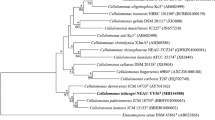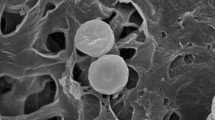Abstract
A Gram-stain positive, facultatively aerobic, motile and rod-shaped bacterial strain, designated THG-SMD2.3T, was isolated from a soil sample collected in a tangerine field, Republic of Korea. According to the 16S rRNA gene sequence comparisons, the isolate was identified as a member of the genus Cellulomonas and to be closely related to Cellulomonas fimi ATCC 484T (98.5%), Cellulomonas biazotea DSM 20112T (98.3%), Cellulomonas chitinilytica X.bu-bT (98.0%), Cellulomonas xylanilytica XIL11T (97.2%), Cellulomonas humilata ATCC 25174T (97.1%) and Cellulomonas composti TR7-06T (97.0%). The 16S rRNA gene sequence similarities with other current species of the genus Cellulomonas were in the range 95.4–96.6%. Catalase and oxidase tests were found to be positive. The DNA G+C content was determined to be 73.0 mol%. DNA-DNA hybridization values between strain THG-SMD2.3T and C. fimi ATCC 484T, C. biazotea DSM 20112T, C. chitinilytica X.bu-bT, C. xylanilytica XIL11T, C. humilata ATCC 25174T and C. composti TR7-06T were 58.1 ± 1.6%, 56.7 ± 0.8%, 30.3 ± 1.6%, 22.8 ± 1.6%, 19.9 ± 1.6%, and 13.5 ± 3.0%, respectively. Strain THG-SMD2.3T was also found to be able to grow at 20–42 °C, at 0–3% NaCl and at pH 5.5–10. The major fatty acids were identified as anteiso-C15:0, iso-C15:0, anteiso-C17:0 and iso-C14:0. The predominant menaquinone was identified as tetrahydrogenated menaquinones with nine isoprene units [MK-9(H4)]. The polar lipids were found to be diphosphatidylglycerol, phosphatidylethanolamine, phosphatidylglycerol, two unidentified aminolipids and two unidentified phospholipids. Based on these phenotypic, genotypic and phylogenetic characterisations strain THG-SMD2.3T (= KACC 19341T = CGMCC 1.16303T) is concluded to represent a novel species of the genus Cellulomonas, for which the name Cellulomonas aurantiaca sp. nov. is proposed.

Similar content being viewed by others
Abbreviations
- DPG:
-
Diphosphatidylglycerol
- PG:
-
Phosphatidylglycerol
- PE:
-
Phosphatidylethanolamine
- PL:
-
Unidentified phospholipids
- AL:
-
Unidentified aminophospholipid
- GL:
-
Unidentified glycolipid
- L:
-
Unidentified lipid
References
Ahmed I, Kudo T, Abbas S, Ehsan M, Iino T, Fujiwara T, Ohkuma M (2014) Cellulomonas pakistanensis sp. nov., a moderately halotolerant Actinobacteria. Int J Syst Evol Microbiol 64:2305–2311
An DS, Im WT, Yang HC, Kang MS, Kim KK, Jin L, Ki MK, Lee ST (2005) Cellulomonas terrae sp. nov., a cellulolytic and xylanolytic bacterium isolated from soil. Int J Syst Evol Microbiol 55:1705–1709
Bagnara C, Toci R, Gaudin C, Belaich JP (1985) Isolation and characterization of a cellulolytic microorganism, Cellulomonas fermentans sp. nov. Int J Syst Bacteriol 35:502–507
Bergey DH, Harrison FC, Breed RS, Hammer BW, Huntoon FM (1923) Bergey’s manual of determinative bacteriology, 1st edn. The Williams & Wilkins Co, Baltimore, pp 1–442
Brown JM, Frazier RP, Morey RE, Steigerwalt AG, Pellegrini GJ, Daneshvar MI, Hollis DG, Mcneil MM (2005) Phenotypic and genetic characterization of clinical isolates of CDC coryneform group A-3: proposal of a new species of Cellulomonas, Cellulomonas denverensis sp. nov. J Clin Microbiol 43:1732–1737
Buck JD (1982) Nonstaining (KOH) method for determination of gram reactions of marine bacteria. Appl Environ Microbiol 44:992–993
Collins MD, Jones D (1980) Lipids in the classification and identification of coryneform bacteria containing peptidoglycans based on 2, 4-diaminobutyric acid. J Appl Bacteriol 48:459–470
Collins MD, Pascual C (2000) Reclassification of Actinomyces humiferus (Gledhill and Casida) as Cellulomonas humilata nom. corrig., comb. nov. Int J Syst Evol Microbiol 50:661–663
Collins MD, Pirouz T, Goodfellow M, Minnikin DE (1977) Distribution of menaquinones in actinomycetes and corynebacteria. J Gen Microbiol 100(2):221–230
Eleberson MA, Malekzadeh F, Yazdi MT, Kameranpour N, Noori-daloii MR, Matte MH, Shahamat M, Colwell RR, Sowers KR (2000) Cellulomonas persica sp. nov. and Cellulomonas iranensis sp. nov., mesophilic cellulose-degrading bacteria isolated from forest soils. Int J Syst Evol Microbiol 50:993–996
Ezaki T, Hashimoto Y, Yabuuchi E (1989) Fluorometric deoxyribonucleic acid-deoxyribonucleic acid hybridization in microdilution wells as an alternative to membrane filter hybridization in which radioisotopes are used to determine genetic relatedness among bacterial strains. Int J Syst Bacteriol 39:224–229
Fautz E, Reichenbach H (1980) A simple test for flexirubin-type pigments. Fems Microbiology Lettes 8:87–91
Felsenstein J (1981) Evolutionary trees from DNA sequences: a maximum likelihood approach. J Mol Evol 17:368–376
Felsenstein J (1985) Confidence limits on phylogenies: an approach using the bootstrap. Evolution 39:783–791
Funke G, Pascual Ramos C, Collins MD (1995) Identification of some clinical strains of CDC coryneform group A-3 and A-4 bacteria as Cellulomonas species and proposal of Cellulomonas hominis sp. nov., for some group A-3 strains. J Clin Microbiol 33:2091–2097
Hall TA (1999) BioEdit: a user-friendly biological sequence alignment editor and analysis program for Windows 95/98/NT. Nucleic Acids Symp Ser 41:95–98
Hatayama K, Esaki K, Ide T (2013) Cellulomonas soli sp. nov. and Cellulomonas oligotrophica sp. nov., isolated from soil. Int J Syst Evol Microbiol 63:60–65
Hu HY, Lim BR, Goto N, Fujie K (2001) Analytical precision and repeatability of respiratory quinones for quantitative study of microbial community structure in environmental samples. J Microbiol Methods 47:17–24
Jones BE, Grant WD, Duckworth AW, Schumann P, Weiss N, Stackebrandt E (2005) Cellulomonas bogoriensis sp. nov., an alkaliphilic cellulomonad. Int J Syst Evol Microbiol 55:1711–1714
Kang MS, Im WT, Jung HM, Kim MK, Goodfellow M, Kim KK, Yang HC, An DS, Lee ST (2007) Cellulomonas composti sp. nov., a cellulolytic bacterium isolated from cattle farm compost. Int J Syst Evol Microbiol 57:1256–1260
Kellerman KF, Mcbeth IG (1912) The fermentation of cellulose. Zentralblatt fur Bakteriologie Parasitenkunde Infektionskrankheiten und Hygiene. Abteilung II 34:485–494
Kellerman KF, Mcbeth IG, Scale FM, Smith NR (1913) Identification and classification of cellulose dissolving Bacteria. Zentralblatt fur Bakteriologie Parasitenkunde Infektionskrankheiten und Hygiene. Abteilung II. 39:502–522
Kim OS, Cho YJ, Lee K, Yoon SH, Kim M, Na H, Park SC, Jeon YS, Lee JH, Yi H (2012) Introducing EzTaxon-e: a prokaryotic 16S rRNA gene sequence database with phylotypes that represent uncultured species. Int J Syst Evol Microbiol 62:716–721
Kimura M (1980) A simple method for estimating evolutionary rates of base substitutions through comparative studies of nucleotide sequence. J Mol Evol 16:111–120
Komagata K, Suzuki K (1987) Lipid and cell wall analysis in bacterial systematics. Methods Microbiol 19:161–206
Kroppenstedt RM (1982) Separation of bacterial menaquinones by HPLC using reverse phase (RP18) and a silver loaded ion exchanger as stationary phases. J Liq Chromatogr 5:2359–2367
Kumar S, Stecher G, Tamura K (2016) MEGA7: molecular evolutionary genetics analysis version 7.0 for bigger datasets. Mol Biol Evol 33:1870–1874
Lagier JC, Ramasamy D, Rivet R, Raoult D, Fournier PE (2012) Non contiguous-finished genome sequence and description of Cellulomonas massiliensis sp. nov. Stand Genomic Sci 7:258–270
Larkin MA, Blackshields G, Brown N, Chenna R, McGettigan PA, McWilliam H, Valentin F, Wallace IM, Wilm A, Lopez R (2007) Clustal W and Clustal X version 2.0. Bioinformatics 23:2947–2948
Lee CM, Weon HY, Hong SB, Jeon YA, Schumann P, Kroppenstedt RM, Kwon SW, Stackebrandt E (2008) Cellulomonas aerilata sp. nov., isolated from an air sample. Int J Syst Evol Microbiol 58:2925–2929
Mcbeth IG, Scales FM (1913) The destruction of cellulose by bacteria and filamentous fungi. US Dep Agric Bureau Plant Ind Bull 266:1–52
Mesbah M, Premachandran U, Whitman WB (1989) Precise measurement of the G+C content of deoxyribonucleic acid by high-performance liquid chromatography. Int J Syst Bacteriol 39:159–167
Minnikin DE (1984) An integrated procedure for the extraction of bacterial isoprenoid quinones and polar lipids. J Microbiol Methods 2:233–241
Rivas R, Trujillo ME, Mateos PF, Martínez-molina E, Velázquez E (2004) Cellulomonas xylanilytica sp. nov., a cellulolytic and xylanolytic bacterium isolated from a decayed elm tree. Int J Syst Evol Microbiol 54:533–536
Rusznyák A, Tóth EM, Schumann P, Spröer C, Makk J, Szabó G, Vladár P, Márialigeti K, Borsodi AK (2011) Cellulomonas phragmiteti sp. nov., a cellulolytic bacterium isolated from reed (Phragmites australis) periphyton in a shallow soda pond. Int J Syst Evol Microbiol 61:1662–1666
Saitou N, Nei M (1987) The neighbor-joining method: a new method for reconstructing phylogenetic trees. Mol Biol Evol 4:406–425
Sasser M (1990) Identification of bacteria by gas chromatography of cellular fatty acids. USFCC Newsl 20:1–6
Shi Z, Luo G, Wang G (2012) Cellulomonas carbonis sp. nov., isolated from coal mine soil. Int J Syst Evol Microbiol 62:2004–2010
Skerman VBD (1967) A guide to the identification of the genera of bacteria, 2nd edn. Williams & Wilkins, Baltimore
Stabili L, Gravili C, Tredici SM, Piraino S, Talà A, Boero F, Alifano P (2008) Epibiotic Vibrio luminous bacteria isolated from some Hydrozoa and Bryozoa species. Microb Ecol 56:625–636
Stackebrandt E, Kandler O (1980) Cellulomonas cartae sp. nov. Int J Syst Bacteriol 30:186–188
Stackebrandt E, Keddie RM (1986) Genus cellulomonas. In: Garrity G, Brenner DJ, Krieg NR, Staley JR (eds) Bergey’s manual of systematic bacteriology, vol 2. Springer, Berlin, pp 1325–1329
Stackebrandt E, Schumann P, Prauser H (2006) The prokaryotes: a handbook on the biology of bacteria. The family Cellulomonadaceae. Springer, New York, pp 983–1001
Weisburg WG, Barns SM, Pelletier DA, Lane DJ (1991) 16S ribosomal DNA amplification for phylogenetic study. J Bacteriol 173:697–703
Yan ZF, Trinh H, Moya G, Lin P, Li CT, Kook MC, Yi TH (2015) Lysobacter rhizophilus sp. nov., isolated from rhizosphere soil of mugunghwa, the national flower of South Korea. Int J Syst Evol Microbiol 66:4754–4759
Yoon MH, Ten LN, Im WT, Lee ST (2008) Cellulomonas chitinilytica sp. nov., a chitinolytic bacterium isolated from cattle-farm compost. Int J Syst Evol Microbiol 58:1878–1884
Zhang L, Xi L, Qiu D, Song L, Dai X, Ruan J, Huang Y (2013) Cellulomonas marina sp. nov., isolated from deep-sea water. Int J Syst Evol Microbiol 63:3014–3018
Funding
This work was carried out with the support of “Cooperative Research Program for Agriculture Science & Technology Development (Project No. PJ012655042018)” Rural Development Administration, Republic of Korea.
Author information
Authors and Affiliations
Corresponding author
Ethics declarations
Conflict of interest
The authors declare that they have no direct or indirect conflict of interest.
Ethical statement
This article does not contain any studies with human participants or animals performed by any of the authors.
Additional information
Publisher's Note
Springer Nature remains neutral with regard to jurisdictional claims in published maps and institutional affiliations.
Electronic supplementary material
Below is the link to the electronic supplementary material.
Rights and permissions
About this article
Cite this article
Kim, SK., Kook, M., Yan, ZF. et al. Cellulomonas aurantiaca sp. nov., isolated from a soil sample from a tangerine field. Antonie van Leeuwenhoek 112, 1623–1632 (2019). https://doi.org/10.1007/s10482-019-01288-2
Received:
Accepted:
Published:
Issue Date:
DOI: https://doi.org/10.1007/s10482-019-01288-2




